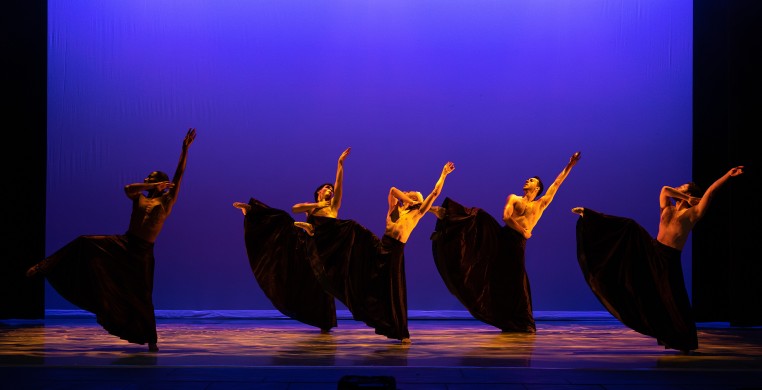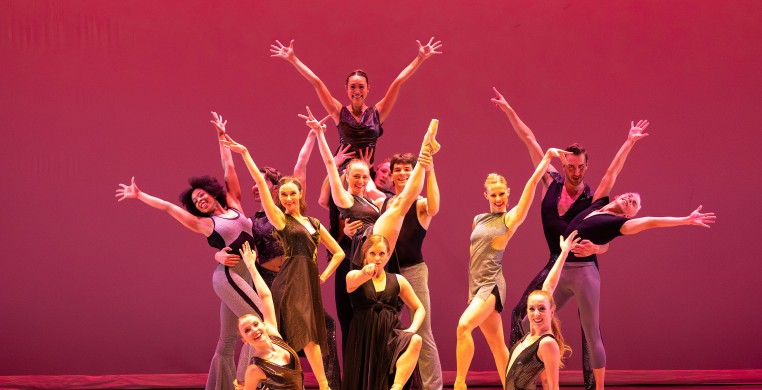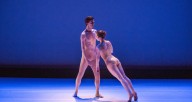Chicago Repertory Ballet’s “Vibrant Vibrations” has been in production since before the pandemic and got nixed at the last second in March of 2020. Far from deterred, Artistic Director Wade Schaaf overcame adversity with a mixed rep program featuring four world premieres, each choreographed by Schaaf, with lighting designs by Jacob Snodgrass and Margaret Nelson performed at the Studebaker Theatre on April 27-30.
Earlier this year, See Chicago Dance conducted an interview with Schaaf about the program and his overarching ideology towards the culture and creation of dance (it gets pretty deep!) and you can read about that here. For now, let’s get to the dancing!
The program begins with “Interconnect” set to an original musical composition by Matty Mattsson, titled “How A Sunflower Survives the End of the World,” consisting of three polyrhythmic sections played by a lone piano, accompanied by an ensemble of buzzing string instruments.
“Interconnect” is a good introduction to Schaaf’s style. Lines of poetry are created through elongated and legato sweeps of bodies punctuated with moments of intensity where limbs curl inward, allowing one’s imagination to envision shapes and images like looking at star constellations. Three duets interspersed throughout the work evoke a feeling of flight and gliding as dancers build up a great speed, leap unabashedly, then are caught and swung around using the full force of their momentum—a near 360-degree vertical rotation is breathtaking!
The meter of the music switches to a galloping 7/8 as lines of dancers scoop at the ground with their arms like poor mudlarks searching for scraps of treasure. The meter changes again to a swaying 6/8 the searching arms reach outward, looks of desperation painting their faces. All except two, who remain poised, connected at the hands, ambivalent to the chaos erupting around them. Even though life is hard, it’s not so bad when you’ve found the one you’ve been looking for.
Set to the music of Claude Debussy, “Song of Songs” is the perfect accompaniment to Spring, with five dancers—men in long, black skirts and bare chests—flitting and fluttering around in the way I imagine sprightly cherubs of Renaissance paintings do in their leisure time when not doting on a deity. Legs fan repeatedly, blooming the skirts in wide elliptic arcs. Hugging is an ongoing motif. Dancers embrace each other, eyes closed shut, rib cages expanding during deep breaths. The unabashed sensations of love, joy, care and serenity in “Song of Songs” leaves a lasting impression on the eye and the heart.

The mood switches to a more oppressive tone in “物の哀れ (The Impermanence of Things).” Dressed in red, five dancers hold their hands up to their faces, shielding their eyes from an overwhelming source of light. There are attempted escapes, but some force stops them one at a time while the others run past, frozen with limbs sharp and angular. Soloist Felicity Nicholson rages against the cruel force bearing down on them but succumbs with the others. They twist and spasm as if trapped in straight jackets. After two joyous and lyrical works, the change of tone in “物の哀れ (The Impermanence of Things)” is a palette cleanser and explores a darker side using light as an oppressive force.
The program concludes with “Move On Up!” using tunes from artists like Gino Soccio and Curtis Mayfield to create a disco dance party. Dressed in a costume that glitters and swirls like a miniature Milky Way galaxy, a figure floats in en pointe and rings small finger bells, a wakeup call for two others sprawled out on the floor. Up they go, joined by a third, a manage a trois of partnering as two pairs of legs wrap around one torso, like a sexy, three-headed chimera. Twin beams hit a disco ball overhead and the room is awash in light; meanwhile, the stage fills with dancers lined up and performing pedestrian movements of the pelvis and shoulders. The sense of personality exuded by the dancers’ sensual stares makes me wriggle in my seat.
Cool moves like Motown/Cholly Atkins backup dancers frame sporadic solos and duets. Pique turns en pointe punctuate the syncopated horn rhythms in Mayfield’s “Move On Up.” Dancer Akilah Harris cuts loose in the center of a semicircle, like a scene out of “Saturday Night Fever.” The work closes with dancers leaping in and out of view, a signature of Schaaf’s, gleefully included at the last minute to create a high-energy, satisfying conclusion.
A malfunction of the Studebaker’s brand new mechanical Austrian curtain provided an unexpected intermission, a bonus, as Schaaf filled time speaking to the crowd, telling jokes and providing insight into the works. Funny, articulate and passionate, Schaaf’s personality—a contemplative wit wrapped in a wry smile—matches their choreography perfectly. Despite the setback of COVID cancelation, Chicago Repertory Ballet have come exploding back onto the scene in grand fashion, as full of energy and vibrancy as ever.


